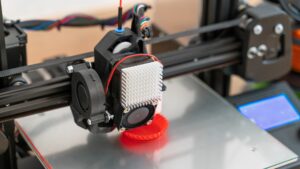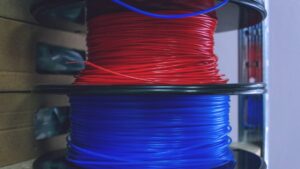
A Look at the Different Densities of 3D Printing Materials
There’s so much to learn about 3D printing materials. Come and find out what to look for when examining the different densities of 3D printing filaments.
844-810-1385
Nylon Carbon Fiber filament is known for its durability, toughness, and industrial-grade stiffness, making it a popular choice for printing tooling, functional prototypes, and high-performance parts. But how do you make Nylon Carbon Fiber filament? Discover the steps and why you just might want to use this filament in your projects below.
The first step in making Nylon Carbon Fiber filament is to gather the raw materials, namely nylon pellets and carbon fibers. Nylon pellets are white, translucent, and look like the tiny plastic beads they are. Carbon fibers come in a range of styles, including short, long, chopped, tow, and filament. Often, manufacturers bundle the chopped microscopic fibers together so that they do not float around, waiting for workers to inhale them.
Blending the raw materials is the next step. This process, the industry calls it compounding, is rather like mixing ingredients when baking a cake. Manufacturers add nylon pellets and carbon fibers in specific ratios and toss them in a giant tumbler. The tumbler evenly distributes the carbon fibers throughout the nylon pellets during this process, resulting in a homogeneous mixture. Compounding also breaks any bundled carbon fibers apart so that they disperse in the blend.
After blending, workers transfer the compounded components to another, smaller mixer. There, the machine stirs the material, and gravity drops it into a heated metal pipe with a large screw in its center. The screw compresses the pellets and fibers, the Nylon begins to melt, and the carbon fibers blend into the viscous liquid. The machine then extrudes the melted plastic blend through a die, which forms the filament into the desired diameter. The extrusion process is just a bigger version of what happens in the hot end of your printer; the output being 1.75 or 2.85 mm generally, not 0.2 to 0.8 mm.
After filament extrusion, the blend passes through a water bath, cooling it quickly so that it does not distort and become oval because of gravity. At Filamatrix, we then pass that filament through a laser inspection station to ensure it has not lost its circular profile. After cooling, workers roll the filament onto spools and vacuum seal them with a desiccant pack to reduce water absorption during storage and shipping.
Making Nylon Carbon Fiber filament requires repeated blending and re-blending, right up to the point that it becomes a 3D print. Understanding the manufacturing process is essential for any avid 3D printer user. It also makes clear why Filamatrix recommends the use of larger nozzles when printing Nylon CF, as the filament can get caught sideways in nozzles smaller than 0.4 mm, making for a troublesome clog.
Look no further than Filamatrix if you’re looking for high-quality Nylon Carbon Fiber filament for 3D printer applications. We provide top-notch, reliable, and durable Nylon Carbon Fiber filament that is perfect for your 3D printing needs. Explore our range of carbon fiber filaments today!
Filamatrix
NEVER. FEEL. LIMITED.

There’s so much to learn about 3D printing materials. Come and find out what to look for when examining the different densities of 3D printing filaments.

Those interested in 3D printing have a lot to learn on how to use the system properly. Find out what you need to know about 3D printing and humidity levels.

3D printing has many variables that both beginners and experts need to know. Find out what effects temperature has on 3D printer filament.
Get professional insights, industry news, and our latest deals